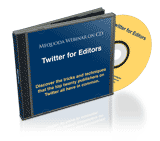| Twitter for Editors: Discover the tricks and techniques that the top twenty publishers on Twitter all have in common.
Dear colleague, When we first started shouting “Twitter!” from the rooftops four years ago, not too many people listened. The concept of “sharing what you ate for breakfast” didn’t seem entirely applicable to the business world. Three years into Twitter’s existence, the almighty Oprah went ahead and started talking about it on her show, and then the masses began to flood in. All of a sudden, Twitter wasn’t just Web 2.0 nerds sitting behind their laptops in the local Starbucks, tweeting away about their stupendous mocha-frappa-latte-spresso with extra poof; it was retail giants like Dell who were suddenly increasing sales by the millions. For publishers, it should have been a no-brainer. Twitter is a micro-publishing platform, and our websites do nothing but push content. We were already writing blogs every day and sending email newsletters. The largest publisher Twitter accounts today are the ones who didn’t wait for someone to give them the “go ahead”—they just dove into it. The New York Times boasts the biggest Twitter following of any publisher on Twitter and has been tweeting since March 2007, less than a year after Twitter launched. [bttn_webinar]The launch period is over… now what?If it’s 2011 and you “get” Twitter now, then you don’t need to be convinced to join. Check that off the list. You don’t need someone to tell you that Twitter isn’t about “what you ate for breakfast” because you’ve already seen how it’s worked for others and how it can work for you. Another check mark for the list. So now what? You’ve got your account and you’ve got a pretty good idea of what you’re supposed to be Tweeting. The big question now is: what’s next? What are the strategies that you can use going forward in order to make the most out of your account, get more followers and start becoming one of those companies that people are “talking about”? This is the biggest question on the minds of most publishers. So you’re on Twitter… now what? In our Twitter for Editors webinar, we’ve decided to help you find the answer to that question. That’s right, we’re going to help you. Nobody can answer it for you in the same way you can’t ask a stranger to write your business plan. It requires inside knowledge and testing to find out exactly what will work for you. In Twitter for Editors, we unload all of the tools and know-how that social media experts are using to run the accounts of publishing empires like People, The New York Times, Reader’s Digest and more… [bttn_webinar]What do the most popular publisher accounts on Twitter have in common?Even the smallest publishers have to look to their largest competitors for insight every once in a while. • What are they doing that works? In Twitter for Editors, we can at least shed some light on their social media efforts and how you can either implement their strategies or make them better. We realize that some publishing brands will get along just fine in social media simply because of their brand. That’s why we’re not going to tell you to do exactly what they’re doing. What we will do, is show you what they’re doing right. For example, the Chicago Tribune has two main accounts. Their newspaper Twitter account does nothing but tweet headlines. This is perfect for readers who are looking simply for news from this publication. That sort of strategy is perfect for their 45k followers. I should probably mention that these 45k followers are only 5% of their Twitter audience. Here’s where the other 95% are…. The Chicago Tribune is smart enough to know that most people don’t want to be blasted with every piece of news that comes out of their website. So for those other 829k people (the other 95%) they have another Twitter account, dubbed @ColonelTribune, “a more gentlemanly version of @ChicagoTribune”. In this webinar, we’ll show you exactly why Colonel Tribune gets 95% of the Twitter audience for the Chicago Tribune and how you can implement the same strategies in your own publications. We’ll also test this same method against several other publishers to show you exactly what makes for a highly followed Twitter feed. [bttn_webinar] Take your Twitter feed from zero to hero…This Twitter webinar isn’t for newbies, and it’s not for slackers. Twitter for Editors will show you how to write better tweets, converse with followers in a more meaningful way and track your time to make sure it’s being well spent. To be more specific, here are the 10 strategies we’ll discuss during this 90-minute webinar: Performing Twitter Audits There are so many online tools that you can use to build and develop your Twitter presence. We’ll show you the steps for finding your competition as well as your potential followers. You’ll then discover how you can use this information to build your own Twitter strategy. Learning Your Lingo Twitter lingo was built by its users, so it’s no wonder that there’s not a style guide or definitive list of acronyms used on the platform. We’ll briefly review the lingo that will define the tweets you’ll be seeing throughout the presentation. Writing Better Tweets We’ll dive into the depths of Twitter tweets to show you how some of the top twenty publisher Twitter accounts construct their tweets. We’ll reveal the most common best practices from Time to Sports Illustrated to the New Yorker to Harvard Business Review and People. Using Twitter Search For any publisher, even those not yet using social media, Twitter Search can be a valuable asset. We’ll show you the best ways to use this tool in order to organize events, watch your brand reputation, find new followers and join discussions. [bttn_webinar] Participating More Rather than leaving Twitter to those minutes in between everything else you’re doing, we’ll show you how to use it a little better. We’re not talking about simply having conversations with those who reach out to you, we’ll show you the techniques for getting more people to mention, retweet and talk about you. Making Lists
Twitter’s list feature is becoming more and more useful for any marketer on Twitter. We’ll show you not only how to create lists that are useful for your users, but also how to join lists that will build your followers and reputation. Tweet Organization Even the most productive marketer can’t use the Twitter.com interface for administering a Twitter account. That’s why in this webinar, we’ll show you which apps (both paid and free) you can use to more effectively spend your time. You’ll learn the magic of scheduled tweets and working with several accounts all in one interface. Getting More Followers Every business wants more followers. How precise can this metric really be? You don’t get control over who follows you, but what you do have control over is your exposure. We’ll show you the one thing that every top publisher on Twitter has in common. Here’s a hint — it has nothing to do with what they’re tweeting. One of these publishers actually has more followers than they do unique website visitors every month! Trying Automation Even the more organic social media experts use some form of automation. We’ll show you the most “accepted” tools for businesses looking to cut a little time out of social media every day. Tracking Everything So you spend two hours on Twitter everyday… now what? How ever will you be able to prove that those hours you spent commenting on one person’s posts resulted in a three thousand dollar sale? Well, you won’t be able to without the tools and strategies that we’re going to divulge at the end of this webinar. [bttn_webinar]At the end of the day… what have you done?This is the final question that we want to answer at the end of this 90-minute Twitter for Editors webinar. That’s why we’ve laid out the most easy-to-follow checklist and plan for you to use going forward.
Cordially,
Amanda MacArthur |
[bttn_webinar]
Speaker: Amanda MacArthur Social Media Specialist Mequoda Group
|
Comments





